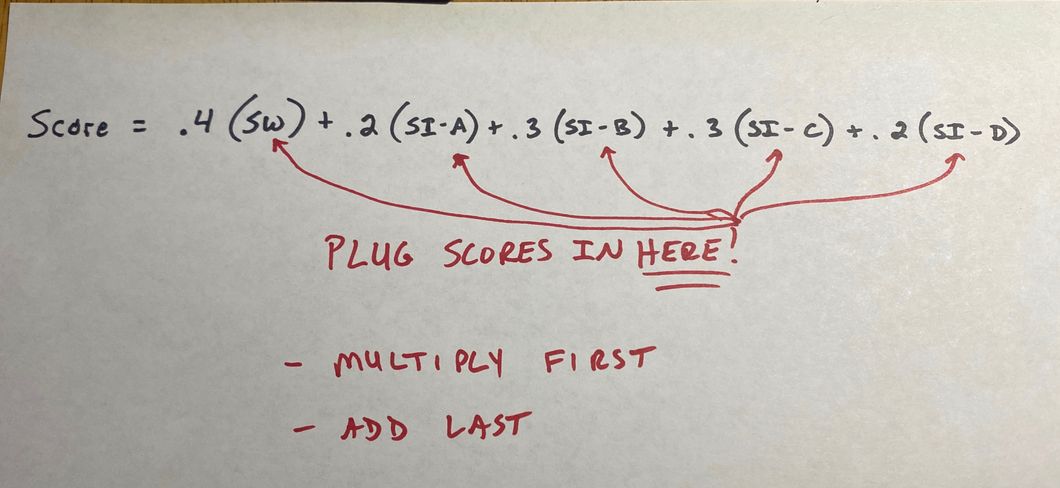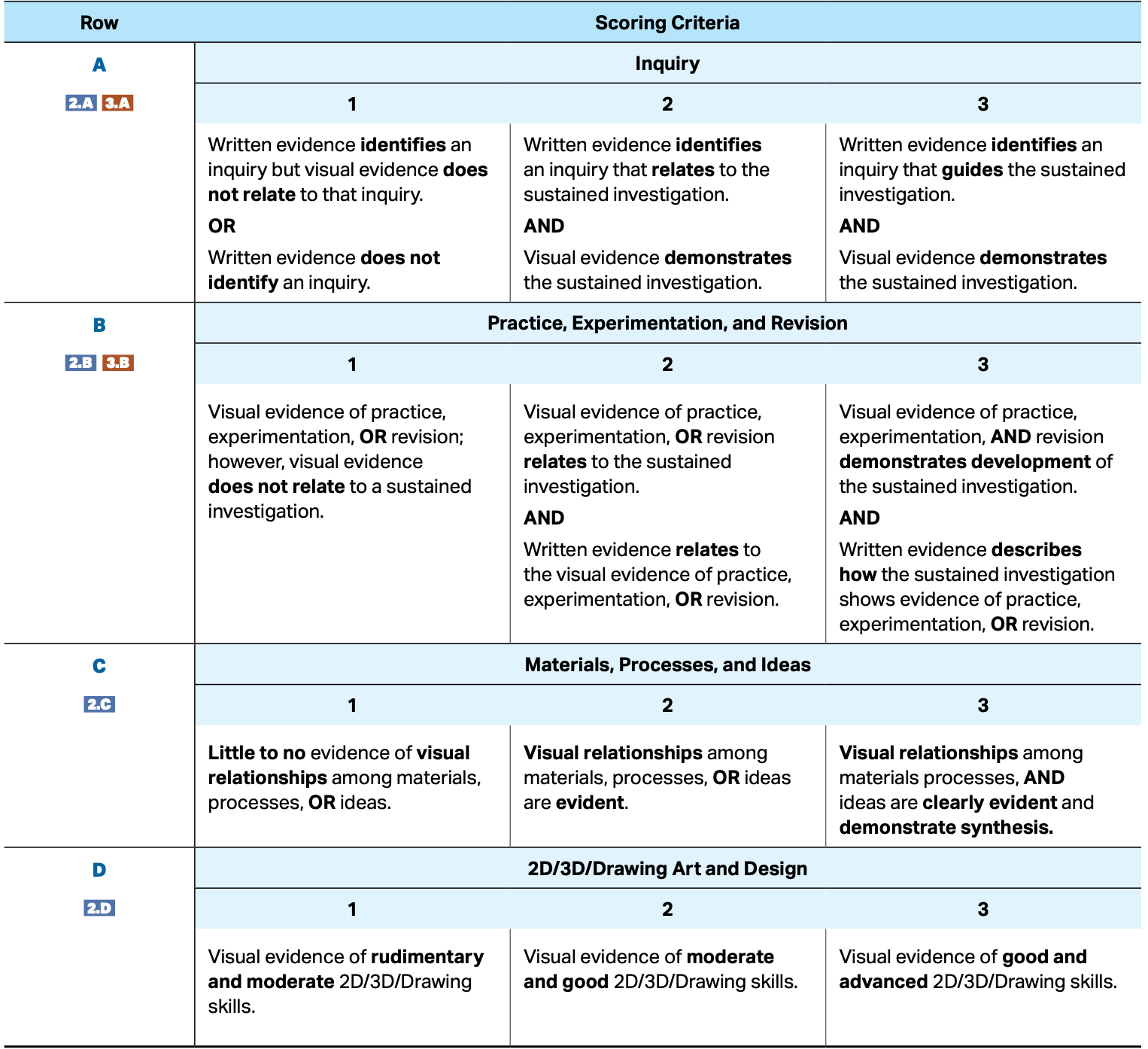
4.1 Score Makeup
2 min read•october 27, 2020
Sherry Ross
Sherry Ross
Deciphering the AP Art and Design Rubric
There are two parts to your test, the Sustained Investigation and the Selected Works. Each one of these has a designed for that section that measures specific "requirements and prompts" that you need to successfully demonstrate. The (CB) states that the is "the contract with the student", so it is incredibly important that you understand what they are talking about in it. 😉
I'm going to break these down for you, but here is the site for more information: Selected Works and Sustained Investigation Rubrics.
General Scoring Note
states that: "When applying the , the score for each row should be considered independently from the other rows. Students may receive different scores for each row. When applying the for each individual row, you should award the score for that row-based solely upon the indicated for that row, according to the preponderance of the evidence. "
This means you select the score point achieved for each row. The body of work is graded holistically (as a whole, all together) for each row. There is a formula you have to plug them into to get the credit score for this section. The total score generated by that formula will represent 60% of your score. Please see the row breakdown below - trust me, it gets easier. 🙂
How Is My Work Scored?
The two parts of your portfolio are combined to make your score. The Selected Works portion provides 40% of your score. The Sustained Investigation portion supplies the other 60%. More importantly, the Sustained Investigation is broken down into four sections, and each row, independently, has a portion of that percentage. Here's the breakdown:
- Row A - 12%
- Row B - 18%
- Row C - 18%
- Row D - 12%
If you are someone who "likes to do the math", more power to you! 👌🏽 Here's a formula to use to create a rough approximation of your score.

This is not a guarantee of a particular score, but you can use this tool as a way to predictively score your work and figure out where you need to concentrate to move your score as you work. 👍🏽 💯 🙌🏽
The Rubric

Key Terms to Review (5)
AP Art and Design
: The AP Art and Design course is an advanced level art program offered to high school students. It allows students to explore various artistic mediums, develop their skills, and create a portfolio of artwork that demonstrates their understanding of the principles and elements of art.College Board
: The College Board is an organization that administers standardized tests, including the AP Art & Design exams. They set the curriculum and guidelines for these exams.Criteria
: Criteria refers to the specific standards or guidelines used to evaluate or assess something. In the context of art and design, criteria are the established benchmarks that determine the quality and success of a work.Rubric
: A rubric is a scoring guide used to evaluate student work based on predetermined criteria. It provides clear expectations for what is required to achieve different levels of performance.Scoring
: Scoring refers to assigning points or marks to evaluate student performance on an exam, assignment, or project. It determines how well students have met specific criteria outlined in a rubric or grading system.4.1 Score Makeup
2 min read•october 27, 2020
Sherry Ross
Sherry Ross
Deciphering the AP Art and Design Rubric
There are two parts to your test, the Sustained Investigation and the Selected Works. Each one of these has a designed for that section that measures specific "requirements and prompts" that you need to successfully demonstrate. The (CB) states that the is "the contract with the student", so it is incredibly important that you understand what they are talking about in it. 😉
I'm going to break these down for you, but here is the site for more information: Selected Works and Sustained Investigation Rubrics.
General Scoring Note
states that: "When applying the , the score for each row should be considered independently from the other rows. Students may receive different scores for each row. When applying the for each individual row, you should award the score for that row-based solely upon the indicated for that row, according to the preponderance of the evidence. "
This means you select the score point achieved for each row. The body of work is graded holistically (as a whole, all together) for each row. There is a formula you have to plug them into to get the credit score for this section. The total score generated by that formula will represent 60% of your score. Please see the row breakdown below - trust me, it gets easier. 🙂
How Is My Work Scored?
The two parts of your portfolio are combined to make your score. The Selected Works portion provides 40% of your score. The Sustained Investigation portion supplies the other 60%. More importantly, the Sustained Investigation is broken down into four sections, and each row, independently, has a portion of that percentage. Here's the breakdown:
- Row A - 12%
- Row B - 18%
- Row C - 18%
- Row D - 12%
If you are someone who "likes to do the math", more power to you! 👌🏽 Here's a formula to use to create a rough approximation of your score.

This is not a guarantee of a particular score, but you can use this tool as a way to predictively score your work and figure out where you need to concentrate to move your score as you work. 👍🏽 💯 🙌🏽
The Rubric

Key Terms to Review (5)
AP Art and Design
: The AP Art and Design course is an advanced level art program offered to high school students. It allows students to explore various artistic mediums, develop their skills, and create a portfolio of artwork that demonstrates their understanding of the principles and elements of art.College Board
: The College Board is an organization that administers standardized tests, including the AP Art & Design exams. They set the curriculum and guidelines for these exams.Criteria
: Criteria refers to the specific standards or guidelines used to evaluate or assess something. In the context of art and design, criteria are the established benchmarks that determine the quality and success of a work.Rubric
: A rubric is a scoring guide used to evaluate student work based on predetermined criteria. It provides clear expectations for what is required to achieve different levels of performance.Scoring
: Scoring refers to assigning points or marks to evaluate student performance on an exam, assignment, or project. It determines how well students have met specific criteria outlined in a rubric or grading system.
Resources
© 2024 Fiveable Inc. All rights reserved.
AP® and SAT® are trademarks registered by the College Board, which is not affiliated with, and does not endorse this website.